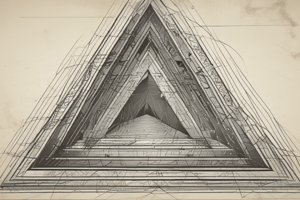Podcast
Questions and Answers
Which condition must be met for two triangles to be considered similar?
Which condition must be met for two triangles to be considered similar?
- They must have the same angles. (correct)
- They must have equal areas.
- They must be the same size.
- They must have proportionate side lengths.
If triangles are similar, what can be deduced about their corresponding sides?
If triangles are similar, what can be deduced about their corresponding sides?
- They are all the same size.
- They are proportional to one another. (correct)
- They are equal in length.
- They have a constant ratio that varies with size.
What is the ratio of the sides in a triangle with angles of 30°, 60°, and 90°?
What is the ratio of the sides in a triangle with angles of 30°, 60°, and 90°?
- 1:2:3
- 2:1:$ rac{1}{2}$
- 1:$ rac{ oot{3}}{2}$:1 (correct)
- 1:$ rac{ oot{2}}{2}$:$ rac{3}{2}$
Which of the following statements about the order of vertices in similar triangles is true?
Which of the following statements about the order of vertices in similar triangles is true?
In similar triangles
$ riangle ABC$ and $ riangle DEF$, what is true about angles A, B, and C?
In similar triangles $ riangle ABC$ and $ riangle DEF$, what is true about angles A, B, and C?
What must be true for two triangles to have proportional sides?
What must be true for two triangles to have proportional sides?
Which of the following ratios represents the equality in corresponding sides of similar triangles?
Which of the following ratios represents the equality in corresponding sides of similar triangles?
What happens to the ratio of corresponding side lengths if the angle remains constant in similar triangles?
What happens to the ratio of corresponding side lengths if the angle remains constant in similar triangles?
Which of the following properties is true for similar triangles?
Which of the following properties is true for similar triangles?
In similar triangles, if one pair of sides is proportional, what can be inferred about the other pairs?
In similar triangles, if one pair of sides is proportional, what can be inferred about the other pairs?
If triangle ABC is similar to triangle DEF, what relationship holds between the angles?
If triangle ABC is similar to triangle DEF, what relationship holds between the angles?
What is the consequence of not maintaining the correct order of vertices when labeling similar triangles?
What is the consequence of not maintaining the correct order of vertices when labeling similar triangles?
Which of the following ratios is consistent for similar triangles with corresponding sides?
Which of the following ratios is consistent for similar triangles with corresponding sides?
When comparing triangle ABC with triangle GHK, which statement about their corresponding angles is accurate?
When comparing triangle ABC with triangle GHK, which statement about their corresponding angles is accurate?
What relationship exists between the areas of similar triangles, such as ABC and DEF?
What relationship exists between the areas of similar triangles, such as ABC and DEF?
Which of these must be true for triangles to be similar?
Which of these must be true for triangles to be similar?
In the context of similar triangles, if triangle ABC is similar to triangle DEF, which of the following must be true?
In the context of similar triangles, if triangle ABC is similar to triangle DEF, which of the following must be true?
Which of the following describes the relationship between the angles of similar triangles?
Which of the following describes the relationship between the angles of similar triangles?
What does the notation $ \Delta ABC \sim \Delta DEF $ imply about the triangles?
What does the notation $ \Delta ABC \sim \Delta DEF $ imply about the triangles?
If triangle ABC has side lengths in the ratio 3:4:5, what would be the corresponding sides of a similar triangle DEF with a ratio of 6:8:10?
If triangle ABC has side lengths in the ratio 3:4:5, what would be the corresponding sides of a similar triangle DEF with a ratio of 6:8:10?
Which of the following scenarios correctly demonstrates the properties of similar triangles?
Which of the following scenarios correctly demonstrates the properties of similar triangles?
What assumption can be made about the lengths of corresponding sides when comparing two similar triangles?
What assumption can be made about the lengths of corresponding sides when comparing two similar triangles?
When two triangles are similar, what can be concluded about their corresponding sides and angles?
When two triangles are similar, what can be concluded about their corresponding sides and angles?
If two triangles have corresponding angles of 45°, 45°, and 90°, which of the following statements is true about their side lengths?
If two triangles have corresponding angles of 45°, 45°, and 90°, which of the following statements is true about their side lengths?




